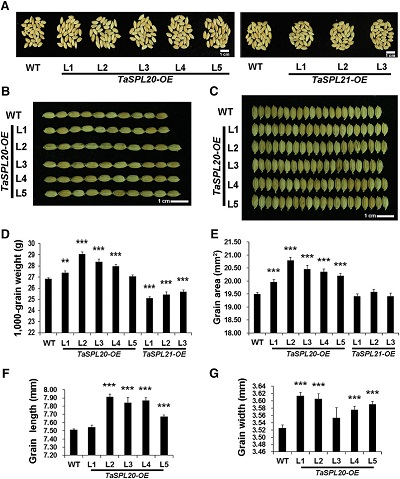Functional Conservation and Divergence among Homoeologs of TaSPL20 and TaSPL21, Two SBP-Box Genes Governing Yield-Related Traits in Hexaploid Wheat1[OPEN]
作 者:Bin Zhang, Weina Xu, Xia Liu, Xinguo Mao, Ang Li, Jingyi Wang, Xiaoping Chang, Xueyong Zhang,and Ruilian Jing*
影响因子: 6.456
刊物名称: Plant Physiology
出版年份: 2017
卷: 期:174: 1177–1191 页码:
doi:10.1104/pp.17.00113.
文章摘要 :
Maintaining high and stable yields has become an increasing challenge in wheat breeding due to climate change. Although Squamosa-promoter binding protein (SBP)-box genes have important roles in plant development, very little is known about the actual biological functions of wheat SBP-box family members. Here, we dissect the functional conservation, divergence, and exploitation of homoeologs of two paralogous TaSPL wheat loci during domestication and breeding. TaSPL20 and TaSPL21 were highly expressed in the lemma and palea. Ectopic expressions of TaSPL20/21 in rice exhibited similar functions in terms of promoting panicle branching but had different functions during seed development. We characterized all six TaSPL20/21 genes located across the three homoeologous (A, B, and D) genomes. According to the functional analysis of naturally occurring variants in 20 environments, four favorable haplotypes were identified. Together, they reduced plant height by up to 27.5%, and TaSPL21-6D-HapⅡ increased 1000-grain weight by 9.73%. Our study suggests that TaSPL20 and TaSPL21 homoeologs underwent diversification in function with each evolving its own distinctive characteristics. During domestication and breeding of wheat in China, favorable haplotypes of each set were selected and exploited to varying degrees due to their large effects on plant height and 1000-grain weight.





